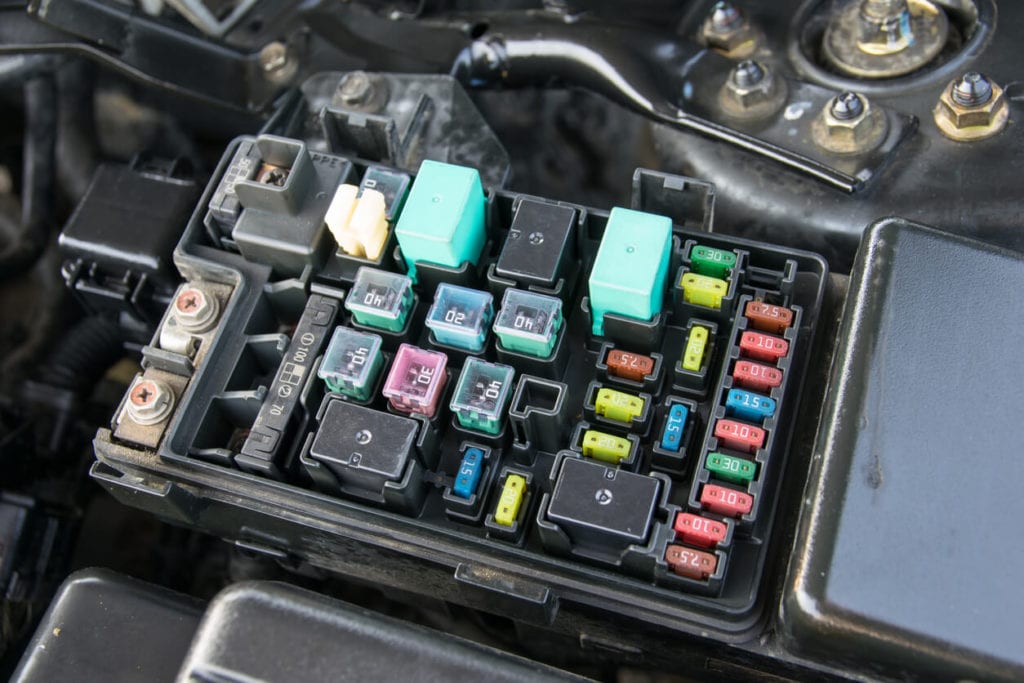 Fuse boxes are made to protect electrical circuits in the car from exposure to the elements preventing damage and short circuits. Fuses are made to control and safeguard electrical currents that flow through wires to electrical components. Drivers may experience difficulties with the radio, dome lights, and other electrical components within the vehicle when fuses are blown. While you may suspect your battery or alternator is responsible for a loss in electrical mechanisms, it’s entirely possible a blown fuse is the cause. Any time multiple fuses blow, it’s likely the fuse box is experiencing some sort of difficulty. Car fuse box service may be required when your car experiences troubles with one or more electrical components.
Fuse boxes are made to protect electrical circuits in the car from exposure to the elements preventing damage and short circuits. Fuses are made to control and safeguard electrical currents that flow through wires to electrical components. Drivers may experience difficulties with the radio, dome lights, and other electrical components within the vehicle when fuses are blown. While you may suspect your battery or alternator is responsible for a loss in electrical mechanisms, it’s entirely possible a blown fuse is the cause. Any time multiple fuses blow, it’s likely the fuse box is experiencing some sort of difficulty. Car fuse box service may be required when your car experiences troubles with one or more electrical components.
If your vehicle was not equipped with fuses, an overloaded electrical current could cause wiring to overheat, melting the insulation, and could cause a fire. A large current to any electrical mechanism will cause instant failure. Fuses stabilize currents, allowing the mechanism to function seamlessly. On occasion though, the current may be too much for even the fuse causing it to blow. A fuse may have blown in your vehicle if you are struggling to start your vehicle, are no longer able to operate your headlights, windshield wipers, interior lights, radio, or other electrical components.
The Fuse Box
Locations of fuse boxes in vehicles may vary. The vehicle owner’s manual will provide details on where the fuse box is located in a car. Many vehicles possess two fuse boxes which are often located in the engine compartment as well as the inside the vehicle beneath or within the dashboard. Each box has a different purpose. The engine compartment fuse box is made to protect certain engine components including the anti-lock brake pump, engine control unit, and cooling system while the interior fuse box is used to protect cabin area electrical elements. Fuse boxes contain several fuses for many different functions and relays in one space, for convenience and protection from damages due to weather or collisions.
Fuses within the fuse box come in many different shapes, colors, and sizes. They’re used to stabilize the electrical current flowing through wires, protecting electronics from damage due to an overload of electricity. Most fuses in today’s vehicles are either a rectangular or cylinder shape. Rectangular fuses come with two push in-connectors that are linked by the fuse wiring protected by a plastic cover, which will blow when overloaded. Cylinder fuses have a similar look to a fluorescent light bulb. Either end has a protective housing with glass between the two. Between the metal ends is a thin fuse wire, protected by the glass, which burns through and blows when overloaded.
Causes of Blown Fuses
While difficulty of just one electrical item is likely caused by a blown fuse, multiple electrical problems could be the result of a poor wiring harness or within the vehicle’s internal computer. Seeking the expertise of a trained professional should be your next step. For example, when the fuse box is clicking, and the car won’t start, a relay is often to blame because by some sort of failure from the vehicle’s computer, struggles within the ground wire on the control side of the relay, or difficulty with the power supply to the control area of the relay. Determining the cause is difficult and will require the use of a technician’s scan tool.
Electrical problems in vehicles that aren’t caused by the alternator or battery, are likely the result of a fuse that has overheated and melted, disrupting the flow of electricity. In some cases, a blown fuse may just be the symptom of a bigger problem, many times fuses blow from age and usage, or drivers and passengers have overloaded the vehicle’s accessories. Additionally, fuses blow from using the incorrect amperage than what is recommended or is of poor quality. Avoid replacing a 10-amp fuse with a 30-amp fuse. The 10-amp is designed to blow at a lesser current rate, when a 30-amp permits a higher current to pass through. A higher current passing through an area designed only for lower currents may result in damage to the component.
Fuses are the protectors of your vehicle’s electrical mechanisms. Relays within the fuse box help protect passengers from the high voltage produced by the battery and alternator. The fuse box is designed to house the fuses and relays to prevent damage from weather conditions, water, and other driving situations. Car fuse boxes may fail because of overheating for several reasons, particularly, added electrical accessories or components that produce overloaded currents.
